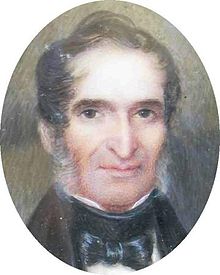Gobrecht dollar
In 1835, Director of the United States Mint Samuel Moore resigned his post, and Robert M. Patterson assumed the position.
After a small quantity was struck for circulation, the Mint received complaints regarding the prominent placement of Gobrecht's name on the dollar, and the design was modified to place his name in a less conspicuous position.
[2] In 1831, Mint Director Samuel Moore noticed a reversal; a large shipment of Spanish dollars had recently been shipped from Canton to the United States.
[5] Shortly thereafter, Director Patterson approached two well-known Philadelphia artists, Titian Peale and Thomas Sully, to create a design that would be used to overhaul most of the American coins then in production.
[6] Mint Chief Engraver Kneass prepared a sketch based on Patterson's conception, but soon suffered a stroke, leaving him partially incapacitated.
"[7] In the same letter, Patterson also informed Sully of his vision for the reverse, which Peale would execute: "I propose an Eagle flying, and rising in flight, amidst a constellation, irregularly dispersed, of 24 stars [representing the number of states then forming the Union], and carrying in its claws a scroll with the words E PLURIBUS UNUM".
[9] In September 1835, Thomas Sully received from Patterson a set of British coins and medals to help guide him while creating the Seated Liberty design.
[10] Sully sent Patterson three rough sketches near the beginning of October, and those were given to Gobrecht, who in turn set about making a copper engraving of the design.
Gobrecht completed the engraving on October 14, and Patterson presented prints created from it to several government officials in an effort to gain their approval.
[10] On October 17, while Jackson and his cabinet were reviewing the design, Woodbury wrote Patterson giving permission to proceed with creating dies for the new coins based on the prints.
Some of the Gobrecht dollars produced were struck with 'medal alignment', meaning that the obverse and reverse images both face upward when the coin is rotated around its vertical axis.
[17] Numismatic historian Walter Breen asserts that those pieces struck before the passage of this act are technically patterns (or coins created to test their design, composition or other points), as they were not authorized by Congress.
[22] It is unknown precisely why the orientation of the eagle was altered, though it is believed by many numismatists that Snowden did this intentionally to make restrikes distinguishable from originals.
[22] Numismatic historian Walter Breen suggests that Snowden simply used the alignment because that was the same used on the Flying Eagle cent,[22] which began production in 1856.
[23] Mint Engraver James B. Longacre, its designer, had borrowed Gobrecht and Peale's eagle reverse for the one-cent coin's obverse.




